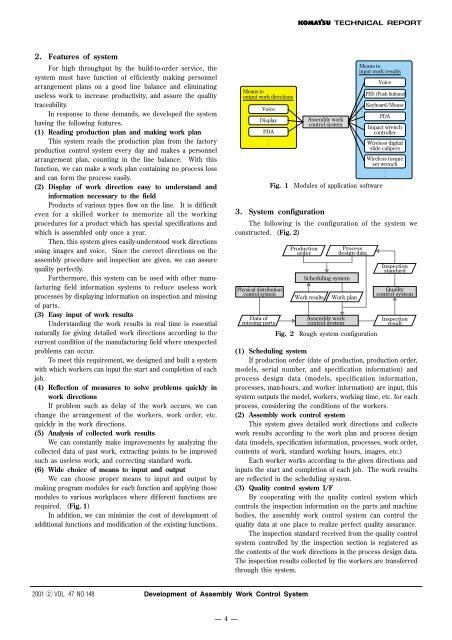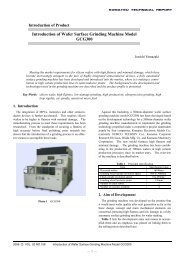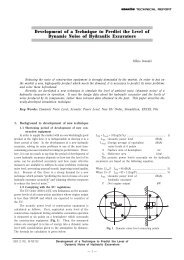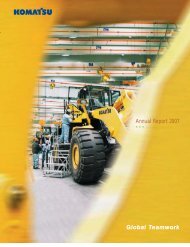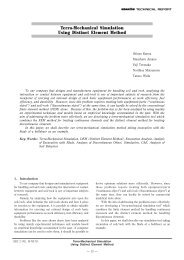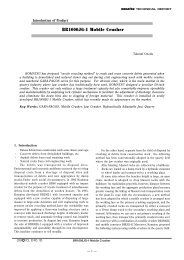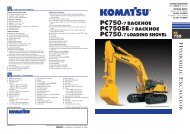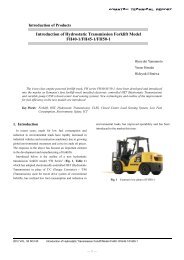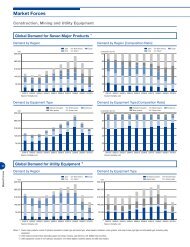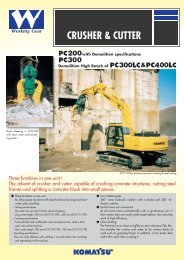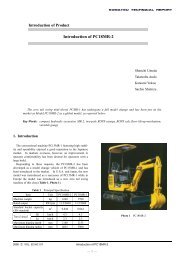Development of Assembly Work Control System - Komatsu
Development of Assembly Work Control System - Komatsu
Development of Assembly Work Control System - Komatsu
Create successful ePaper yourself
Turn your PDF publications into a flip-book with our unique Google optimized e-Paper software.
2. Features <strong>of</strong> system<br />
For high throughput by the build-to-order service, the<br />
system must have function <strong>of</strong> efficiently making personnel<br />
arrangement plans on a good line balance and eliminating<br />
useless work to increase productivity, and assure the quality<br />
traceability.<br />
In response to these demands, we developed the system<br />
having the following features.<br />
(1) Reading production plan and making work plan<br />
This system reads the production plan from the factory<br />
production control system every day and makes a personnel<br />
arrangement plan, counting in the line balance. With this<br />
function, we can make a work plan containing no process loss<br />
and can form the process easily.<br />
(2) Display <strong>of</strong> work direction easy to understand and<br />
information necessary to the field<br />
Products <strong>of</strong> various types flow on the line. It is difficult<br />
even for a skilled worker to memorize all the working<br />
procedures for a product which has special specifications and<br />
which is assembled only once a year.<br />
Then, this system gives easily-understood work directions<br />
using images and voice. Since the correct directions on the<br />
assembly procedure and inspection are given, we can assure<br />
quality perfectly.<br />
Furthermore, this system can be used with other manufacturing<br />
field information systems to reduce useless work<br />
processes by displaying information on inspection and missing<br />
<strong>of</strong> parts.<br />
(3) Easy input <strong>of</strong> work results<br />
Understanding the work results in real time is essential<br />
naturally for giving detailed work directions according to the<br />
current condition <strong>of</strong> the manufacturing field where unexpected<br />
problems can occur.<br />
To meet this requirement, we designed and built a system<br />
with which workers can input the start and completion <strong>of</strong> each<br />
job.<br />
(4) Reflection <strong>of</strong> measures to solve problems quickly in<br />
work directions<br />
If problem such as delay <strong>of</strong> the work occurs, we can<br />
change the arrangement <strong>of</strong> the workers, work order, etc.<br />
quickly in the work directions.<br />
(5) Analysis <strong>of</strong> collected work results<br />
We can constantly make improvements by analyzing the<br />
collected data <strong>of</strong> past work, extracting points to be improved<br />
such as useless work, and correcting standard work.<br />
(6) Wide choice <strong>of</strong> means to input and output<br />
We can choose proper means to input and output by<br />
making program modules for each function and applying those<br />
modules to various workplaces where different functions are<br />
required. (Fig. 1)<br />
In addition, we can minimize the cost <strong>of</strong> development <strong>of</strong><br />
additional functions and modification <strong>of</strong> the existing functions.<br />
Means to<br />
output work directions<br />
Voice<br />
Display<br />
PDA<br />
.<br />
Physical distribution<br />
control system<br />
Data <strong>of</strong><br />
missing parts<br />
<strong>Assembly</strong> work<br />
control system<br />
Means to<br />
input work results<br />
Voice<br />
Fig. 1 Modules <strong>of</strong> application s<strong>of</strong>tware<br />
Production<br />
order<br />
Scheduling system<br />
<strong>Work</strong> results<br />
Process<br />
design data<br />
<strong>Work</strong> plan<br />
<strong>Assembly</strong> work<br />
control system<br />
PHS (Push buttons)<br />
Keyboard/Mouse<br />
PDA<br />
Impact wrench<br />
controller<br />
Wireless digital<br />
slide calipers<br />
Wireless torque<br />
set wrench<br />
.<br />
3. <strong>System</strong> configuration<br />
The following is the configuration <strong>of</strong> the system we<br />
constructed. (Fig. 2)<br />
Fig. 2 Rough system configuration<br />
Inspection<br />
standard<br />
Quality<br />
control system<br />
Inspection<br />
result<br />
(1) Scheduling system<br />
If production order (date <strong>of</strong> production, production order,<br />
models, serial number, and specification information) and<br />
process design data (models, specification information,<br />
processes, man-hours, and worker information) are input, this<br />
system outputs the model, workers, working time, etc. for each<br />
process, considering the conditions <strong>of</strong> the workers.<br />
(2) <strong>Assembly</strong> work control system<br />
This system gives detailed work directions and collects<br />
work results according to the work plan and process design<br />
data (models, specification information, processes, work order,<br />
contents <strong>of</strong> work, standard working hours, images, etc.)<br />
Each worker works according to the given directions and<br />
inputs the start and completion <strong>of</strong> each job. The work results<br />
are reflected in the scheduling system.<br />
(3) Quality control system I/F<br />
By cooperating with the quality control system which<br />
controls the inspection information on the parts and machine<br />
bodies, the assembly work control system can control the<br />
quality data at one place to realize perfect quality assurance.<br />
The inspection standard received from the quality control<br />
system controlled by the inspection section is registered as<br />
the contents <strong>of</strong> the work directions in the process design data.<br />
The inspection results collected by the workers are transferred<br />
through this system.<br />
2001 w VOL. 47 NO.148<br />
<strong>Development</strong> <strong>of</strong> <strong>Assembly</strong> <strong>Work</strong> <strong>Control</strong> <strong>System</strong><br />
— 4 —


